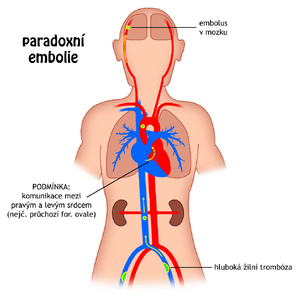Paradoxical embolism
From WikiLectures
Paradoxical embolism is a special type of embolism in which venous thrombus is embolized into the arteries of the systemic circulation by way of a right-to-left short circuit. This type of embolization is often thought of by neurologists in patients with open foramen ovale (and aneurysm of the atrium) who have had a cryptogenic stroke ( TIA).[1]
In the vast majority of cases, thrombi originating from the veins of the lower limbs or from the right heart into lungs embolize. Very rarely, these thrombi can enter the systemic circulation. In order for such a situation to occur, two conditions must be met:
- there must be communication between the right and left atria (atrial septal defect, foramen ovale patens);
- the pressure in the right atrium must exceed the pressure in the left atrium (normally the pressure in the left atrium is higher → the pressure gradient is from the left atrium to the right. An increase is needed for the blood to flow in the opposite direction) pressure in the right atrium and reversal of the pressure gradient, which could occur, for example, with simultaneous embolization into the lungs).
Links[edit | edit source]
Related articles[edit | edit source]
References[edit | edit source]
- ↑ RIEDEL, Martin. Paradoxní embolie a kryptogenní cévní mozková příhoda. Interv Akut Kardiol. 2003, y. 1, vol. 2, p. 82-85, ISSN 1803-5256.
References[edit | edit source]
- NEČAS, Emanuel. Patologická fyziologie orgánových systémů I. 1. edition. Praha : Karolinum, 2003. 760 pp. ISBN 80-246-0675-5.

